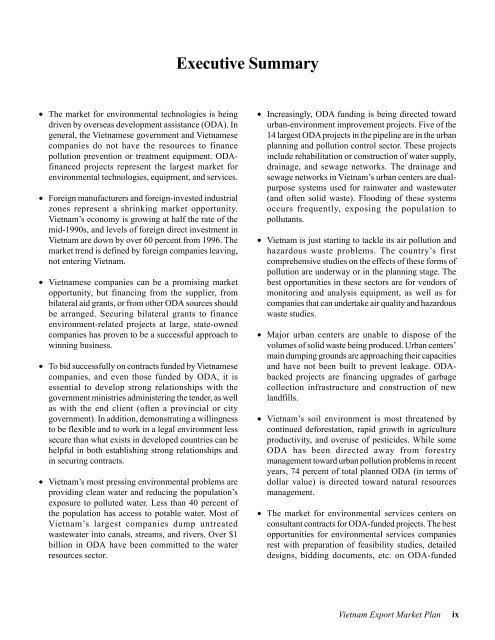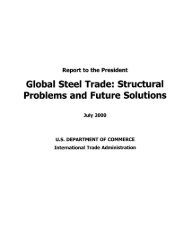Vietnam Environmental Technologies Export Market Plan
Vietnam Environmental Technologies Export Market Plan
Vietnam Environmental Technologies Export Market Plan
You also want an ePaper? Increase the reach of your titles
YUMPU automatically turns print PDFs into web optimized ePapers that Google loves.
Executive Summary<br />
• The market for environmental technologies is being<br />
driven by overseas development assistance (ODA). In<br />
general, the <strong>Vietnam</strong>ese government and <strong>Vietnam</strong>ese<br />
companies do not have the resources to finance<br />
pollution prevention or treatment equipment. ODAfinanced<br />
projects represent the largest market for<br />
environmental technologies, equipment, and services.<br />
• Foreign manufacturers and foreign-invested industrial<br />
zones represent a shrinking market opportunity.<br />
<strong>Vietnam</strong>’s economy is growing at half the rate of the<br />
mid-1990s, and levels of foreign direct investment in<br />
<strong>Vietnam</strong> are down by over 60 percent from 1996. The<br />
market trend is defined by foreign companies leaving,<br />
not entering <strong>Vietnam</strong>.<br />
• <strong>Vietnam</strong>ese companies can be a promising market<br />
opportunity, but financing from the supplier, from<br />
bilateral aid grants, or from other ODA sources should<br />
be arranged. Securing bilateral grants to finance<br />
environment-related projects at large, state-owned<br />
companies has proven to be a successful approach to<br />
winning business.<br />
• To bid successfully on contracts funded by <strong>Vietnam</strong>ese<br />
companies, and even those funded by ODA, it is<br />
essential to develop strong relationships with the<br />
government ministries administering the tender, as well<br />
as with the end client (often a provincial or city<br />
government). In addition, demonstrating a willingness<br />
to be flexible and to work in a legal environment less<br />
secure than what exists in developed countries can be<br />
helpful in both establishing strong relationships and<br />
in securing contracts.<br />
• <strong>Vietnam</strong>’s most pressing environmental problems are<br />
providing clean water and reducing the population’s<br />
exposure to polluted water. Less than 40 percent of<br />
the population has access to potable water. Most of<br />
<strong>Vietnam</strong>’s largest companies dump untreated<br />
wastewater into canals, streams, and rivers. Over $1<br />
billion in ODA have been committed to the water<br />
resources sector.<br />
• Increasingly, ODA funding is being directed toward<br />
urban-environment improvement projects. Five of the<br />
14 largest ODA projects in the pipeline are in the urban<br />
planning and pollution control sector. These projects<br />
include rehabilitation or construction of water supply,<br />
drainage, and sewage networks. The drainage and<br />
sewage networks in <strong>Vietnam</strong>’s urban centers are dualpurpose<br />
systems used for rainwater and wastewater<br />
(and often solid waste). Flooding of these systems<br />
occurs frequently, exposing the population to<br />
pollutants.<br />
• <strong>Vietnam</strong> is just starting to tackle its air pollution and<br />
hazardous waste problems. The country’s first<br />
comprehensive studies on the effects of these forms of<br />
pollution are underway or in the planning stage. The<br />
best opportunities in these sectors are for vendors of<br />
monitoring and analysis equipment, as well as for<br />
companies that can undertake air quality and hazardous<br />
waste studies.<br />
• Major urban centers are unable to dispose of the<br />
volumes of solid waste being produced. Urban centers’<br />
main dumping grounds are approaching their capacities<br />
and have not been built to prevent leakage. ODAbacked<br />
projects are financing upgrades of garbage<br />
collection infrastructure and construction of new<br />
landfills.<br />
• <strong>Vietnam</strong>’s soil environment is most threatened by<br />
continued deforestation, rapid growth in agriculture<br />
productivity, and overuse of pesticides. While some<br />
ODA has been directed away from forestry<br />
management toward urban pollution problems in recent<br />
years, 74 percent of total planned ODA (in terms of<br />
dollar value) is directed toward natural resources<br />
management.<br />
• The market for environmental services centers on<br />
consultant contracts for ODA-funded projects. The best<br />
opportunities for environmental services companies<br />
rest with preparation of feasibility studies, detailed<br />
designs, bidding documents, etc. on ODA-funded<br />
<strong>Vietnam</strong> <strong>Export</strong> <strong>Market</strong> <strong>Plan</strong><br />
ix
















